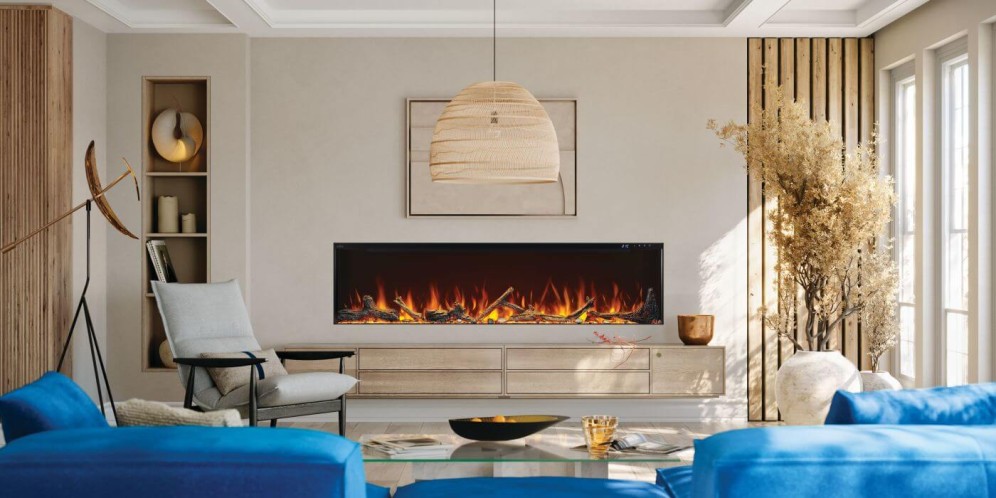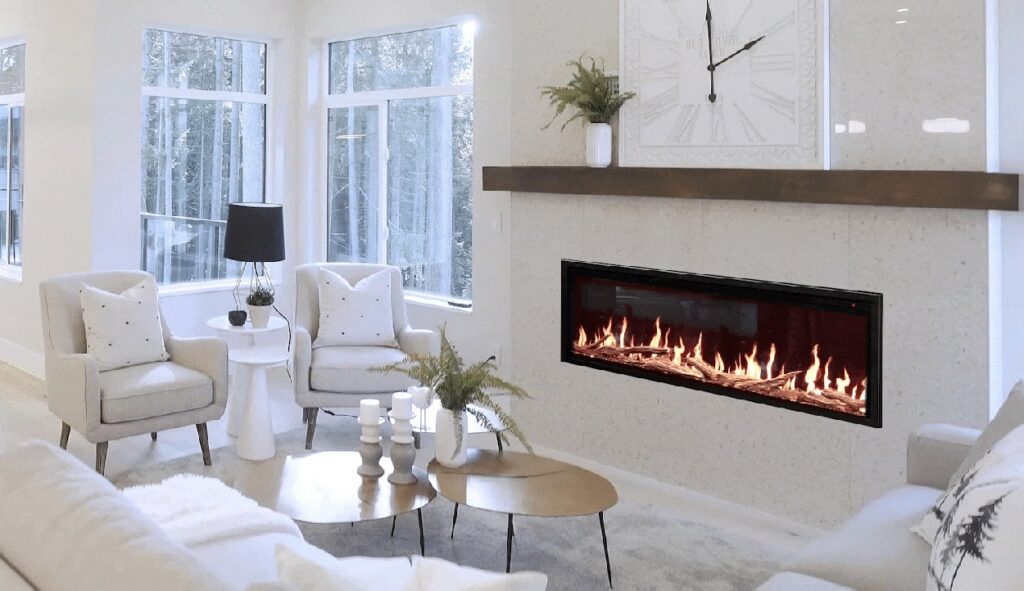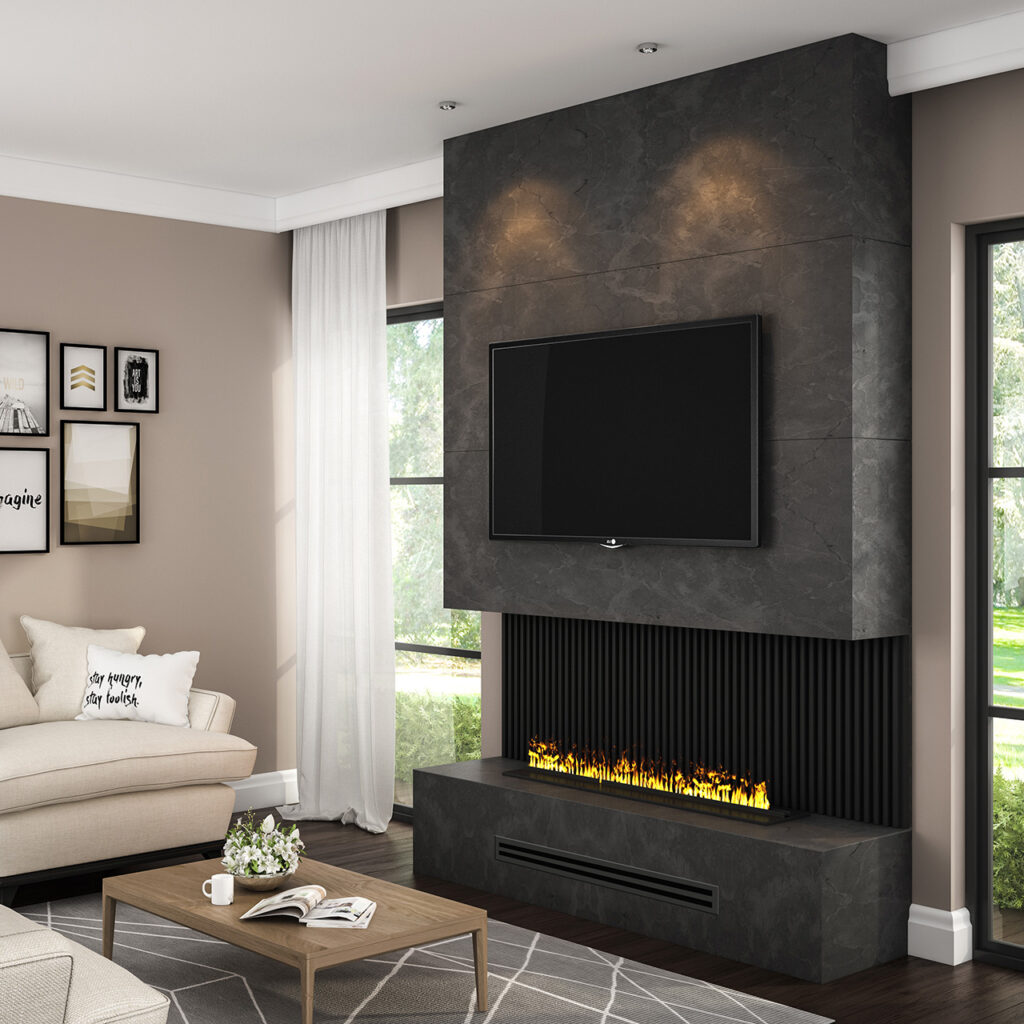If you’ve been looking for a clean, green fireplace alternative for your home, then you will have discovered that electric fireplaces are the most efficient and affordable of all fireplaces. But what do you know about what makes them that way? A gas fireplace burns natural gas or propane. A wood-burning fireplace burns wood. What is burning in an electric fireplace? How do electric fireplaces work?

Most electric fireplaces work with LEDs
At one time, before LEDs were developed, electric fireplaces worked with regular incandescent light bulbs inside. These bulbs provided a lovely warm light for the flames, but could not change colours. They also had a limited lifespan, and eventually needed to be replaced. Because lightbulbs took up more space than today’s LEDs, there was a limit to how slim an electric fireplace could be manufactured. When LED lightbulbs were developed, we were at least able to replace burned-out incandescent bulbs, to extend the length of time before the next replacement. However, it was the transition from screw-in lightbulbs to miniature LEDs that was a huge leap forward in electric fireplace design.
An LED is a Light Emitting Diode, which is an extremely compact source of light. That light can be created in a range of colours, from the warm yellows and oranges of a fire to every other colour in the spectrum. That’s why today’s electric fireplaces usually offer multiple flame colours, as well as a range of accent lighting colours. LEDs use very little power to create their light effects, so they are an extremely efficient way to provide the lights and flame effects inside an electric fireplace. LEDs also have a very long lifespan, so they usually don’t need to be replaced over the lifetime of the fireplace. And because LEDs are so compact, electric fireplaces may be manufactured in profiles as slim as 3.5 inches.
How are the flames created on an LED electric fireplace?
LEDs alone cannot create a flame effect. Electric fireplaces come to life when that LED light takes on the appearance of flickering flames. So how does this part of an electric fireplace work? First of all, electric fireplaces have a translucent background in the middle of the fireplace. In some cases, that back panel is also reflective, which enhances the flames by making them appear to be coming from a burner in the middle of the fireplace (as they would on a gas fireplace). Having a reflective back panel also makes the fireplace look deeper than it is, which is a bonus in a some of the slimmer electric fireplace models.
In addition to the backdrop, there may be a flame panel, or a flame stencil, inside the fireplace. This panel has flame-shaped cut-outs through which the light is reflected onto the back panel. If an electric fireplace has a flame panel, you will see those shapes appear in the flames. If the flames are more ‘wispy’ or smoky, then there is not a flame panel inside the fireplace. Some electric fireplace manufacturers, like Amantii, give you a choice about the flame ‘stencil’.
What makes that light appear to be flickering is the flicker rod. A flicker rod is a rod wrapped in pieces of reflective material, which bounces the light onto the flame panel or back panel. A small motor causes the flicker rod to turn, which gives movement to the flames. Not all electric fireplaces have a flame panel, but an LED fireplace will always have a flicker rod.

How do video electric fireplaces work?
As homeowners switch from gas fireplaces to electric, the demand for more realistic electric fireplaces is growing. In response, some fireplace manufacturers are turning to video projection, or LCD (liquid crystal diode), to recreate the look of gas or wood-burning fires. It’s a bit like having a TV screen inside the fireplace. Instead of LEDs and flicker rods, LCD electric fireplaces rely on video of real flames, either from a gas fireplace or a wood-burning fire. These electric fireplaces are still enhanced with coloured accent lights, like regular LED fireplaces, and they have the added feature of real fire sounds, which have been captured in the flame videos.

How do water vapour electric fireplaces work?
In addition to LED and LCD technologies, there are electric fireplaces that create realistic flames by turning tap water into mist. When that mist is hit with the warm glow of LEDs, it looks like live flames. It’s important to note that the water is turned into a very fine mist with an ultrasonic transducer, which ‘shakes’ the water into droplets. It is not steam, or vapour, so there is no risk of burns. Dimplex created this technology under the Optimyst name, over a decade ago, and has continued to make improvements. Their most recent Optimyst Linear Fireplaces include all the coloured LED accent lighting of their LED fireplaces, in a built-in firebox with glass. These electric fireplaces must have a plumbing connection to keep the reservoirs filled, which can limit their use in some projects.
Do electric fireplaces work without heat?
No matter how an electric fireplace works to create flames, there will be a separate heater and blower, that may be turned on or off independent of the flames. That means that you can have a fire with or without heat, so you can use an electric fireplace year-round, in any size room.
How do you turn on an electric fireplace?
There are 3 ways to turn on and control an electric fireplace. Somewhere on the front of the fireplace, there will be a touchpad, where basic features may be controlled, such as power and the heater. More complex features may not be accessible on the touchpad.
Electric fireplaces also come with a remote control, which can access almost all of the features, including the accent lighting, and thermostat controls. Only a few lockout features will not be accessible on the remote control, as these must be set on the touchpad.
Better-quality electric fireplaces are now being introduced with WiFi connectivity, so they may be controlled via mobile apps, from any mobile device. The advantage of the app is that it is more visual, which is helpful as electric fireplaces become more complex and offer more features and settings. It’s challenging to embed all of these features in a remote control that fits into your hand!